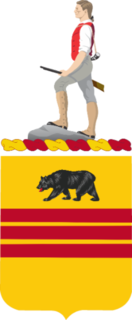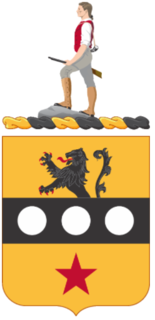
The 2nd Cavalry Division was a cavalry division of the United States Army.

The 199th Infantry Brigade (Light) is a unit of the United States Army which served in the Army Reserve from 1921 to 1940, in the active army from 1966 to 1970, briefly in 1991–1992 at Fort Lewis, and from 2007 as an active army training formation at Fort Benning.

The 194th Armored Brigade is a separate brigade of the US Army.
The National Guard's 22nd Cavalry Division was created from the perceived need for additional cavalry units. It numbered in succession after the Regular Army Divisions, which were not all active at its creation. Going into World War II, the US Army Cavalry contained 3 Regular, 4 National Guard, and 6 Organized Reserve cavalry divisions as well as 1 independent cavalry brigade.
The 23rd Cavalry Division was a cavalry formation of the United States Army National Guard during the interwar period.

The 61st Cavalry Division was an Organized Reserve cavalry unit of the United States Army.

The U.S. Army's 63rd Cavalry Division, Organized Reserve, was created from the perceived need for additional cavalry units. It numbered in succession of the Regular Army Divisions, which were not all active at its creation.
The 64th Cavalry Division of the United States Army Organized Reserve was created from the perceived need for additional cavalry units. It numbered in succession of the Regular Army Divisions, which were not all active at its creation.

The structure of the United States Army is complex, and can be interpreted in several different ways: active/reserve, operational/administrative, and branches/functional areas.

The 2nd Squadron, 107th Cavalry Regiment is a cavalry squadron of the 37th Infantry Brigade Combat Team and the Ohio National Guard located throughout southwest Ohio.

The 308th Cavalry Regiment, commonly referred to as the 308th Cavalry, was a reserve regiment of the United States Army from 1917 until 1942. In September 1918, it was converted into the 65th and 66th Field Artillery, and the 22d Trench Mortar Battery. The units were stationed at Camp Kearny, California. Although demobilized in December 1918, they were re-formed and re-purposed in October 1921 as the 308th Cavalry, an element of the 62d Cavalry Division. During World War II, it was disbanded again. In 1959, the regimental headquarters was transferred to Department of the Army control.
The 154th Cavalry Brigade was a cavalry unit of the United States Army Organized Reserve during the interwar period. Organized in 1922, the brigade spent its entire career with the 62nd Cavalry Division and was disbanded after the United States entered World War II.

The 305th Cavalry Regiment was a cavalry unit of the United States Army during World War I and the interwar period. It was activated in early 1918 but broken up in the middle of the year to form new artillery units. The unit was recreated as a Pennsylvania Organized Reserve unit during the interwar period, and was disbanded after the United States entered World War II.
The 153rd Cavalry Brigade was a cavalry unit of the United States Army Organized Reserve during the interwar period. Organized in 1922, the brigade spent its entire career with the 62nd Cavalry Division and was disbanded after the United States entered World War II.

The 306th Armored Cavalry Regiment was a District of Columbia-based reconnaissance unit of the United States Army Organized Reserve Corps that briefly existed after World War II. The 306th ACR later became a group before being inactivated in 1959.

The 302nd Cavalry Regiment was a cavalry unit of the United States Army during World War I, the interwar period, and the Cold War. It was activated in early 1918 but broken up in the middle of the year to form new artillery units. The unit was recreated as a New Jersey Organized Reserve unit during the interwar period, and was converted into a tank destroyer battalion after the United States entered World War II. Reactivated in 1971 and 1973 in the Army Reserve, it was represented by two squadrons in the 100th Division (Training).

The 311th Cavalry Regiment was a cavalry unit of the United States Army during World War I and the interwar period. It was activated in early 1918 but broken up later that year to form new artillery units. The unit was recreated as a Texas Organized Reserve unit during the interwar period. It was disbanded after the United States entered World War II.

The 312th Cavalry Regiment was a cavalry unit of the United States Army during World War I and the interwar period. It was activated in early 1918 but broken up later that year to form new artillery units. The unit was recreated as an Oklahoma, Arizona, New Mexico, and Colorado Organized Reserve unit during the interwar period. It was converted into a signal aircraft warning regiment after the United States entered World War II.

The 124th Cavalry Regiment is a United States Army cavalry regiment, represented in the Texas Army National Guard by 1st Squadron, 124th Cavalry, part of the 56th Infantry Brigade Combat Team at Waco.















